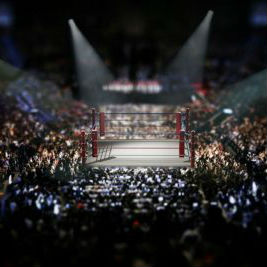
Much has been made over WWE’s failure to develop new top stars, a matter getting more attention with the turmoil inside the company leading to the recent departure of its co-presidents, and the loss of more than a billion dollars in market value in a single day last week.
TV ratings are flat, and flat at near-historic lows. Ticket sales at house shows continue to struggle, which, OK, that’s a function of the flat TV ratings.
It wasn’t supposed to matter, we were told last year, when WWE was announcing huge billion-dollar TV deals with Fox and NBCUniversal, and while there is some insulation from all of those dollars acting as a safety net, Wall Street still isn’t happy with how things are going right now, and it’s not good for publicly-traded companies when Wall Street isn’t happy.
Nor is it good for entertainment companies when the customers are even less happy than the bears on Wall Street.
Viewership for WWE’s weekly “Raw” and “Smackdown” TV shows are down more than a third over the past three years, and before you @ me about cord-cutting impacting everything on TV, consider that the reason Fox and NBCUniversal are giving WWE those billions is because pro wrestling is, ostensibly, live sports programming, destination TV, immune to the vagaries of cord-cutting.
The problem for WWE, in a nutshell: people aren’t watching.
It’s a problem of the company’s own making.
WWE has been following a model that ESPN laid out for itself for a long stretch wherein the effort in terms of creative is to de-emphasize new stars at the expense of putting the focus on the brand.
ESPN blazed this trail, which it has since famously ditched, after its meteoric growth in the 1990s on the backs of personalities like Chris Berman, Keith Olbermann and Dan Patrick.
The bean-counters decided that letting the big stars dictate their own terms was too unpredictable for the bottom line, so ESPN went through a long period with a plug-and-play approach that pushed the ESPN brand above the individual talents.
If you watch ESPN now, you know that the bean-counters who replaced those other bean-counters are taking a different approach, again giving big pushes (and megadollars) to stars like Stephen A. Smith, Scott Van Pelt and Dan Le Batard.
WWE rode the wave of fame that Attitude Era stars like Dwayne “The Rock” Johnson and “Stone Cold” Steve Austin created for themselves in the late 1990s and into the 2000s, but since John Cena began making his transition to Hollywood several years ago, it’s been noticeably quiet on the big-star front.
Sporadic efforts have been made to trying to put over Roman Reigns, to really no avail, and while WWE Chairman Vince McMahon seems to think Brock Lesnar is a compelling foundational roster piece, Lesnar is hardly the mainstream phenomenon that Johnson, Cena or Austin were, or you could say still are, given how much you see McMahon rely on them in cameo roles to push the ratings needle when things get really down.
One advantage that a wrestling booker has over, say, Dana White at UFC, is that the results of the competitions are obviously predetermined, so you don’t set up a story arc for a huge superfight, only to have an upstart rise up and upset a Ronda Rousey, Conor McGregor or Jon Jones, and throw off all your best-laid plans.
If you want to build a star, in other words, you know what you need to do, because if you’re McMahon, you did it with Hulk Hogan in the 1980s, Johnson and Austin in the 1990s, Cena in the 2000s.
The reason there isn’t an heir to the Hogans, Rocks, Stone Colds, Cenas, isn’t because there just isn’t anybody interesting enough to come forward.
It’s because of a strategic move on the part of WWE to make it more about the E than about the stars.
What’s most significant about the big stars of the past is that they all eventually moved on from the McMahon orbit – Hogan to a rival promotion, Johnson and Cena to Hollywood, Austin to a premature retirement after suffering an in-ring injury.
A conscious decision was made to give WWE cover from losing an investment in the build-up of another big star to something bigger.
This is the basis of 50/50 booking, where jobbers from a couple of months ago can get a run with a major title, then return to being jobbers, tag teams are formed out of nowhere and just as quickly broken up, main-eventers this week can go silent for months, then get another main-event push out of nowhere.
ESPN went the same route for years with “SportsCenter” featuring an endless array of nameless, faceless fill-in-the-blanks, supposedly insulated from market pressures with a stable source of revenues from cable fees, until people started cord-cutting, and the folks in Bristol had to adjust their thinking back to what had gotten people interested in the product back in the early days.
WWE will figure this out, eventually, whether it’s under McMahon, or, and don’t overlook this as a possibility, the people who run the business after McMahon.
The shares seem way undervalued where they are now relative to the fundamentals of the business, but it’s going to take somebody getting WWE out of its years-long rut to be able to bring the revenues back in line with where they should be.
If McMahon isn’t the guy to make that happen, don’t be surprised to see somebody force the hand in some way.
Story by Chris Graham










